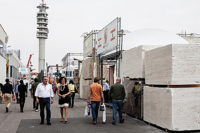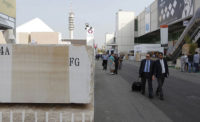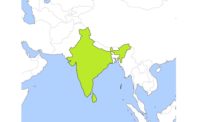The exhibition halls at Marmomacc were a flurry of activity this year — with attendance up 3% from the last edition. The 2015 event, which was held from September 30 to October 3 in Verona, Italy, drew a total of 67,000 attendees worldwide. Celebrating its 50th anniversary this year, Marmomacc offered visitors numerous displays of the latest stone introductions, as well as the newest advances in machinery, tools and accessories, and stone care and maintenance products. For the second consecutive year, the stone exhibition was held in conjunction with Abitare il Tempo, VeronaFiere’s event dedicated to contract, design and interior decor sectors.
It was reported that international attendance comprised 57% of the total showing of people. Visitors came from 150 countries, which was five more than the previous year. There were 1,524 exhibitors occupying nearly 830,000 square feet of space. Exhibitors hailed from 55 countries, including debuts by Albania, Bosnia and Herzegovina, Cameroon, Venezuela and Georgia.
“The show achieved extremely high levels of internationality on all fronts, with significant increases even by geographic areas where we have already been directly and continuously active for many years,” said Giovanni Montovani, CEO & Director General of VeronaFiere. “At the same time, this edition enabled us to organize meetings at the highest institutional and business levels, which will help us develop new partnerships on strategic markets for the core business of VeronaFiere itself.”
“This result is doubly rewarding for us,” said Ettore Riello, president of VeronaFiere. “First and foremost, we have achieved all the goals we set for ourselves for the 50th edition, in terms of qualified attendance, trade delegations and professional operators, with across the board increases that helped create important and new business development opportunities and partnerships for our customers and for Veronafiere itself alike. Secondly, we demonstrated to the government the validity of our conviction of the exhibition tool and its high-profile events as a vital asset for business by SMEs — especially in terms of exports, thereby including Marmomacc on the strength of major results achieved in the course of 50 editions and its high level of internationality in the special ‘Made in Italy’ promotion plan through a structured project also involving the ICE-Italian Trade Agency and Confindustria Marmomacchine.”
The Italian Stone Theatre
With the support of the Ministry for Economic Development the ICE-Italian Trade Agency and Confindustria Marmomacchine, within the scope of the “Made in Italy” promotion plan, which recognized excellence in the Italian natural stone and related technology fields, Marmomacc celebrated its 50th anniversary by dedicating an entire hall — named The Italian Stone Theatre — with technologies and experiments in the stone, exclusively from Italy.
Identified by a logo, the Italian Stone Theatre was a significant celebratory event involving not only natural stone, but also machinery and technology. The ingenuity of designers was paired with the professionalism, construction skills, and technical and productive expertise of Italian companies and machinery.
The overall layout presented high-profile experimental works demonstrating the skills of Italian companies in creating innovative products specially designed by prestigious international architects and designers, through traditional craftsmanship, as well as the use of advanced machinery capable of interacting with sophisticated three-dimensional design programs. The Italian Stone Theatre, curated by the designer Raffaello Galiotto and the architect Vincenzo Pavan, was divided into two theme-based sections with different spatial identities.
One section was dedicated to materials and involved a series of installations linked by a shared, dual theme inspired by concepts of horizontality and verticality — two conditions in the use of stone materials which designers have to tackle on a daily basis.
Horizontality was interpreted through “Carpets of Stone,” a collage of stone floors by several designers installed to form a segmented path, where design imagination and executive precision can demonstrate infinite interpretation possibilities and the textural and chromatic facets offered by stone materials in two-dimensional compositions.
Verticality is represented by “Lithic Vertigo,” a series of three-dimensional installations conceived as islands where walls, stairs and ramps highlighted the potential of stone, in mechanical terms, as well as expressive quality in interpreting architecture through various building components.
The other exhibition section focused on the interaction between stone processing machines and design projects, a crucial step that opens new perspectives for a sector, which until now has experienced problematic access to the market.
The Stone Academy
The Stone Academy brings together universities, professions and institutions involved in training, research and academic-professional promotion activities in architecture based on the use of stone. With the 2015 edition of the show, the Stone Academy and Marmomacc consolidated their partnership with the CNAPP (Italian National Council of Architects, Planners, Conservationists and Landscapers) through the memorandum of understanding signed by Leopoldo Frery (President of CNAPP), Massimiliano Caviasca (President of Stone Academy) and Elena Amadini (Manager, Marmomacc-Veronafiere) with the aim of expanding educational activities dedicated to the use of stone in architecture and design.
In keeping with tradition, Marmomacc is the occasion for meetings involving representatives of Italian universities to discuss studies, research and developments in the natural stone field. Marmomacc also hosted professional training courses and conferences dealing with several topics related to natural stone, from its use in open spaces to restoration work involving architecture and stone artefacts. Theme-based lectures continued after the event until the end of 2015 — dealing with technologies — while a workshop focusing on the re-utilization of quarries was also arranged.
This year also celebrated 10 years since the first course in contemporary design with stone was launched by Marmomacc in collaboration with Milan Polytechnic University.
During the four days of the show, the Architecture & Design cultural space (Castelvecchio Gallery between Halls 2 and 3) presented projects developed by the universities taking part in the Stone Academy program, including the Stone Academy Workshops I 2015 - Feeding with Stone exhibition - Projects for Expo 2015 and the Stone Academy Workshop II 2015 - Apulia, Bridges of Stone exhibition.
The next edition of Marmomacc is scheduled for September 28 to October1, 2016.
Best Communicator Awards 2015
The 9th edition of the Best Communicator Award was held during Marmomacc and Abitare il Tempo. The award program was designed to recognize the best exhibitor stands at each show. The jury, comprised of President Giorgio Tartaro (journalist and television presenter), Michela Baldessari (designer), Fulvio Bonavia (photographer), Silvia Botti (editor of the monthly magazine Abitare) and Andrea Castrignano (interior designer), considered the more than 1,500 exhibiting companies before making their final decision. In total, eight first prizes and five special mentions were presented to companies who presented themselves and their products in the best ways that stood apart from the rest.
The award ceremony was held in the Forum Area of The Italian Stone Theatre at Marmomacc and was attended by the president and Director General and CEO of VeronaFiere, Ettore Riello and Giovanni Mantovani.
Design
For design, the Italy First Prize went to Budri with its stand designed by Patricia Urquiola “for the expressive power of a set-up that enhances the richness of the design project, the quality of the product and the processing skills of the company.”
The International First Prize in the design category went to Levantina y Asociados de Minerales and its booth by Hector Ruiz “for the completeness of the set-up achieved through volumes, heights and depths as well as the creation of carefully designed settings in every detail to highlight the natural stone materials.”
A Special Mention was awarded to the Botticino Quarrymen’s Cooperative with its stand designed by Ivan Tognazzi “for the simplicity of a set-up that captures the attention of visitors and allows an original and unusual presentation of samples.”
Stone
In the stone category, the Italy First Prize went to Antolini and its stand designed by Alessandro La Spada “for skill in representing the world of marble and stone, from the natural block to most refined processing, revealing the various souls of the material, from its most dense and solid dimension to the most artistic and delicate applications.”
The International First Prize in the stone category went to Carrieres du Hainaut with its stand by Jan Devroey “for the decision to place stone in a setting that highlights its potential for use that also creates a welcoming and original space.”
A Special Mention was awarded to Henraux and its stand by Studio Archea “for the smart use of material as part of an intelligent design project capable of turning stone into a series of self-supporting lightweight elements brought together in a spectacular composition.”
Machinery
The Italy First Prize in the machinery category went to Co.Me.S. (stand by Michele Kallonakis with graphics by Gabriele Attuoni) “for the originality of the set-up and the decision to focus on graphics by using macro images of production stages and objects as well as for the museum-mode in which products were displayed.”
A Special Mention was made to Simec with its stand by Marco Davì “for skill in giving shape to a large-scale setting, ensuring visual continuity to the display of exceptionally large machinery.”
Tools
The Italy First Prize for “tools” was given to Italdiamant and its stand developed by Studio45 “for a stand structure that on the one hand recalls shapes of the company’s specialist production and, on the other hand, ensures a friendly setting for meetings and work.”
The International First Prize in the tools category was given to Eurotungstene for its stand by Mr Pier Filippi “for graphic immediacy in communicating a product that is by no means easy to interpret and the decision to create a strict, eye-catching geometry of locations and colors.”
A Special Mention was awarded to Fila Surface Care Solutions for its stand by Cooee Italia: “the skillful use of color, the construction of practical displays and the recurrent message ensured that the company turned a rather difficult product to interpret into something recognizable and familiar.”
Abitare il Tempo
First Prize went to Mobart Ben for its stand by Karin Bombassei “for the interpretation of the main theme of the exhibition and skill in creating a warm and inviting domestic atmosphere thought out in every detail.”
A Special Mention was made to Weiss.Cucinebianchi for its stand by Fabio Mottin “for the essential character of the set-up, the strength of the lighting system sign and the possibility of interaction by visitors.”



















